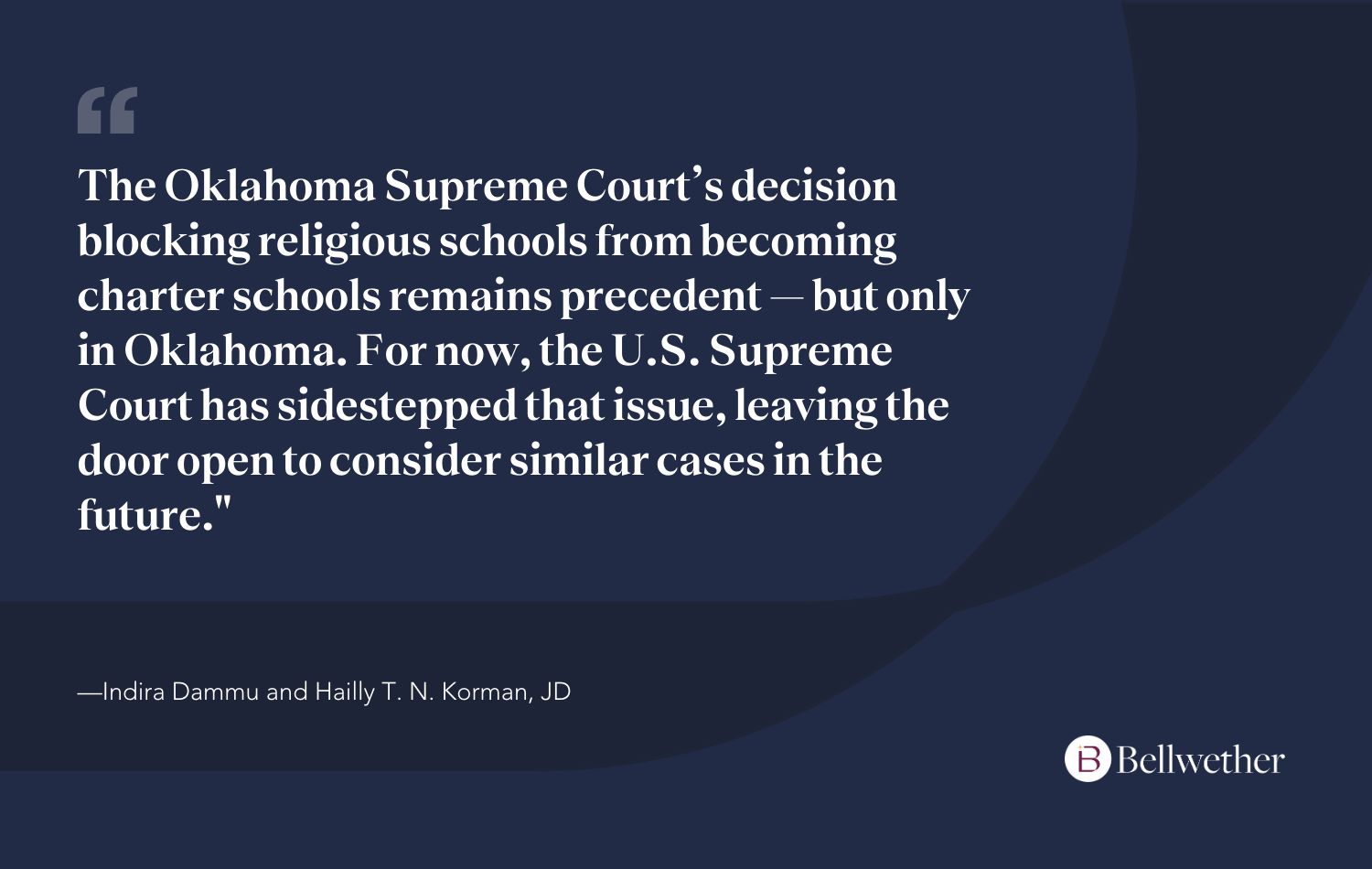In a closely watched case, the U.S. Supreme Court deadlocked on the question of whether a private religious school in Oklahoma can apply to become a public charter school. The vote in Oklahoma Statewide Charter School Board v. Drummond was 4-to-4 — with Justice Amy Coney Barrett recusing herself — and the Court issued a per curiam opinion, meaning it did not offer rationale for the decision nor detail about how the individual judges voted.
This means that the Oklahoma Supreme Court’s decision blocking religious schools from becoming charter schools remains precedent — but only in Oklahoma. The Drummond case could have had wide-ranging implications for students nationwide, possibly going so far as determining that charter schools should be considered private schools, making them ineligible for public funding. For now, the U.S. Supreme Court has sidestepped that issue, leaving the door open to consider similar cases in the future — presumably ones in which Justice Barrett would not need to recuse herself.
Since the Court did not issue an opinion, it is difficult to draw conclusions about how the full bench of justices might rule in those future cases. But the Court has a clear track record in recent years of striking down laws that exclude religious schools from publicly available benefits solely because of their religious nature.
In one of the court’s earliest cases on the matter, Zelman v. Simmons-Harris (2002), a group of parents in Ohio filed a lawsuit against the state’s school voucher program, arguing that it violated the Establishment Clause of the First Amendment since it allowed students to use public money to attend private religious schools. The Court ruled in a 5-to-4 decision that Ohio’s voucher law was neutral to religion and therefore did not violate the Establishment Clause.
Since then, the Supreme Court has continued to weigh in on public funding for religious organizations and schools. In Trinity Lutheran Church of Columbia, Inc. v. Comer (2017), a licensed Missouri preschool that provided religious instruction applied for a statewide grant program that provides funds to purchase recycled tires to resurface playgrounds. The state denied the grant on the grounds that, according to the state constitution, no state money could be given to a church or a religious organization. The preschool then sued the state on religious freedom grounds. In a 7-to-2 Supreme Court decision, the Court sided with the school, ruling that the state violated the First Amendment’s Free Exercise Clause by discriminating against otherwise eligible organizations based solely on their religious nature.
More recently, in 2021, a group of parents in Maine sued the state, arguing that excluding religious schools from the state’s voucher program violated the Free Exercise Clause. The Supreme Court sided with the parents in a 6-to-3 ruling. A year later, in Espinoza v. Montana Department of Revenue (2022), the Supreme Court ruled again that excluding religious schools from receiving state funding violated the Free Exercise Clause.
It’s against this backdrop of affirming access to public funding for religious organizations that the Court took up Oklahoma Statewide Charter School Board v. Drummond this year. This case arose from the Oklahoma Statewide Virtual Charter School Board’s 2023 approval of the application for an online religious charter school. Oklahoma’s attorney general subsequently filed an action in the Oklahoma Supreme Court against the board, claiming that the approval of the religious charter school violated state law because the state constitution called for a “system of public schools … free from sectarian control.” He also argued that approving the school could create a slippery slope, leading to requests from other religious groups that the members of the public might not want to fund.
The Oklahoma Supreme Court sided with the attorney general, ruling that the state charter school board violated both state and federal law when approving the religious school to become a charter school that receives public funds. They also ruled that excluding religious schools from the statewide charter school program did not violate the Free Exercise Clause, because charter schools are government entities.
The charter board appealed the case to the U.S. Supreme Court, setting up two key questions for the Court to consider: Does it violate the Free Exercise Clause to exclude religious schools from charter programs just because they are religious? And do the academic and pedagogical choices of that type of school constitute state action simply because the school contracts with the state via a charter agreement?
This second question was especially significant, given an existing circuit split, and because the Court could have ruled that charter schools should not be classified as public schools, which would have upended the entire charter school sector. The National Alliance for Public Charter Schools submitted an amicus curiae brief urging the Court to rule that charter schools were public schools. They argued that this case posed an “existential threat” to charter schools, since they rely on federal and state funding to operate. If the Court reclassified charter schools as private schools, they could lose access to this funding — forcing many to close and affecting millions of students nationwide.
The split in Drummond offers a reprieve to charter schools on that front for now, but plenty of uncertainty remains. It is likely that the Court will be asked again to consider the limits of public aid for private schools, especially as the federal government seeks to expand funding for private school choice.
